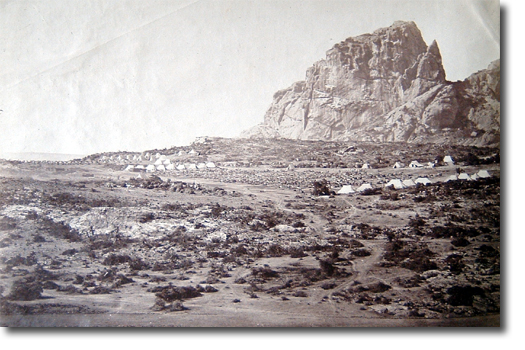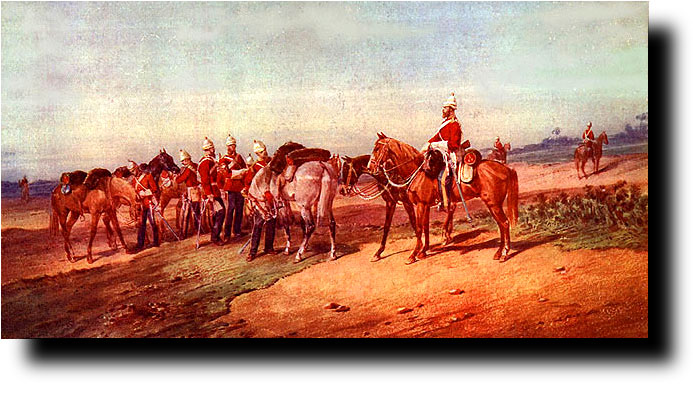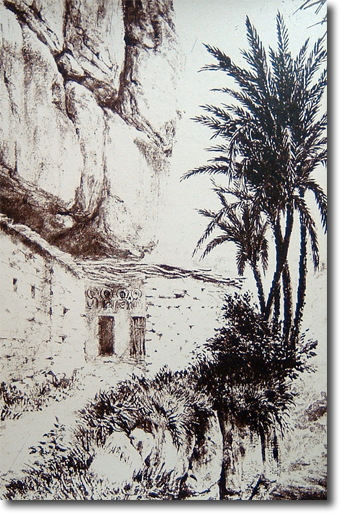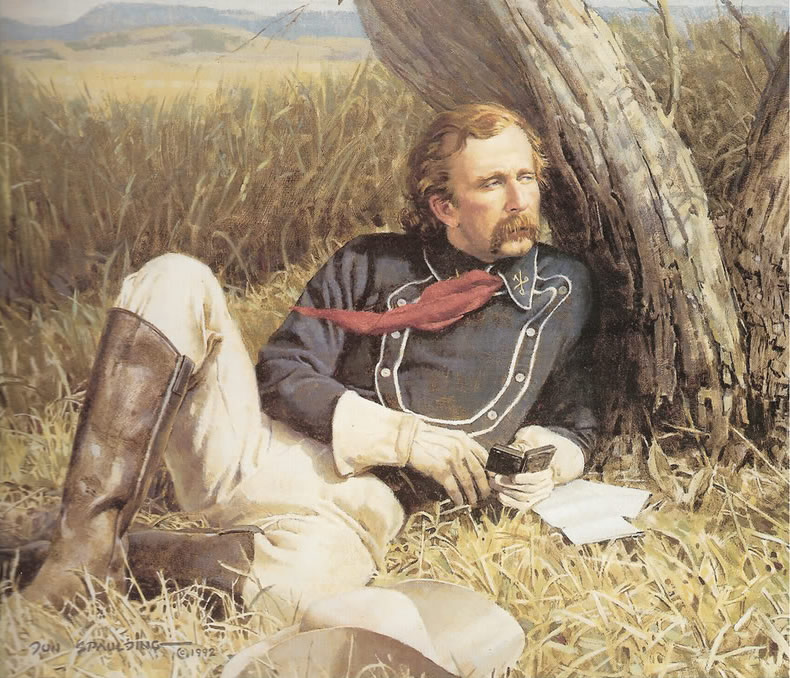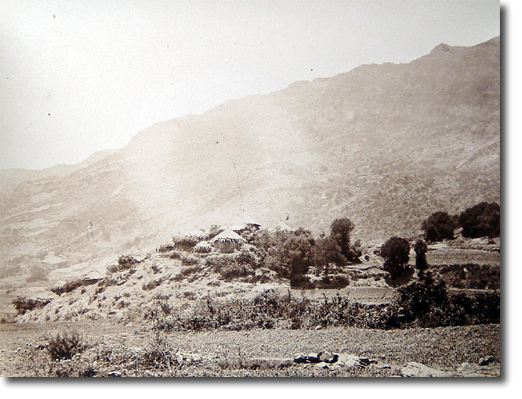Chapter One Hundred and Fifty Seven
A Tourist in the Heart of Darkness
The combined encampment at Senafe
From "Son of the Morning Star" by George A. Custer
Harper and Bros. 1885
“From the forward encampment at Senafe the view was magnificent. The country was rugged and broken by jagged masses of rock which raised their jagged edges, topped with acacia and juniper trees, above the scanty vegetation of the intervening ravines. In the glare of midday this prospect looked hot and thirsty, but in the first glimmerings of the early dawn or when the quickly setting tropic sun had swept down behind the distant hills it was magnificently grand...”
From “An Account of the Recent Campaign in Abyssinia” by Captain J.F. Goodfellow
Macmillan & Co 1870
“At Senafe, which lay some 7,000 feet above the level of the sea, as soon as the sun went down the heat ceased. Warm clothing and heavy blankets were immediately required for the nights were very cold. The great variation in temperature, of necessity, caused an increase in what it was least desirable to increase – baggage...”
From “America in Abyssinia – a reassessment” by Dr. Luther K. Price
Buffalo 1991
“From the outset General Hancock was beset with difficulties of supply. On top of the initial failure to provide cold weather clothing, which Hancock had not overlooked, but which had gone astray somewhere between Norfolk and Alexandria, an epidemic broke out which attacked the horses in the low ground. Both British and American forces were required to quickly push their healthy horses up into the highlands. Having already had to purchase one set of remounts the American treasury was now faced with an almost entirely duplicate expense as another officer had to be sent to Egypt to purchase remounts. Furthermore it quickly became apparent that further transport animals were required if any American forces were to partake in the full march to Magdala. This led to the rather interesting development that one American counsel undertook to forward camels from Arabia to assist General Hancock...”
From "Son of the Morning Star" by George A. Custer
Harper and Bros. 1885
“The transport, and consequently baggage was reduced to the smallest possible dimensions. Officers vied with each other in discarding any article which could be spared for all thirsted to facilitate the advance of the army. I fancy we Americans trumped the British in our ability to march frugally…
Unlike the infantry, who remained exclusively under the command of General Hancock as an independent American brigade, I was brigaded with British regiments. Initially we camped with the Scinde Horse [5th Bombay Cavalry] to which the 3rd Dragoon Guards was later added…
Their red-men and our red-men were exceedingly curious about one another. The 13th seemed most impressed by the beards of the Scinde troopers and referred to them often as the ‘Okchamoli nutakhitch’ [sic] or green beards as the Scinde troopers wore green rather then the expected British red. It is without any apparent irony that they were later to refer to the red tunic’d Dragoon Guards as the ‘red-men’…
It was with no ill-felling that I was informed that an accord had been reached with the British on the subject of seniority. To avoid the embarrassment of almost every British officer being outranked by American lieutenants with brevet colonelcies and majors with brigadier-generalcies it was agreed that only substantive ranks would apply. This meant that Colonel Tower [3rd Dragoon Guards] had command of our brigade but as a veteran of Balaklava and the Charge of the Heavy Brigade I was delighted to serve under his command...”
3rd Dragoons Guards in Abyssinia
From “America in Abyssinia – a reassessment” by Dr. Luther K. Price
Buffalo 1991
“It speaks of General Hancock’s knowledge of his subordinate that he ensured he himself informed Colonel Custer of the accord with General Napier. The accord denied Custer command of the combined cavalry brigade. Had the news been delivered by a staff officer or in a written order in the normal course there would likely have been the most terrible scene. As it was Custer used language to General Hancock during their private interview that Lieutenant Charles Hoyt described (much later in life) as extremely “impolitic”...”
From “An Account of the Recent Campaign in Abyssinia” by Captain J.F. Goodfellow
Macmillan & Co 1870
“Some not present argued that the force that General Napier judged to be necessary and for which he waited too large. They forgot that a line of communication 400 miles in length had to be held open between Magdala and Zulla, with a chain of fortified posts established to cover the stores and depots along it.
They also omitted from consideration that although the natives appeared friendly as long as the expedition was successful and had power, the slightest reverse would convert them all into enemies. That among the Donakill tribes of the mountains the taking of a human life is the sole proof of manhood and the sole passport to marriage, and the uncertain Prince Kassai of Tigre hung upon our right flank with 10,000 at Adowa...
Major Grant, an officer of the intelligence department, was delegated upon an embassy to Prince Kassai at Adowa to convince this Prince of Tigre to let his people open up the markets for the supply of our army. Indeed with out the co-operation of the local peoples on the question of supply the column would have been further encumbered with baggage…
It must be borne in mind that while meat could be obtained and the wood used to cook it could be found scattered over the mountain sides, meat alone in that climate would not suffice for the food of man. Its use as a sole article of food quickly brought on dysentery and scurvy. Vegetables, tea, sugar, spirits and, at the instance of the Americans, coffee had ever to be in the rear of the army...”
From "Son of the Morning Star" by George A. Custer
Harper and Bros. 1885
“8 miles from Senafe was Gooma-gooma. On the northern side of the valley, perched on an almost inaccessible ledge of rock, was situated a church, in which were located some curious paintings and illustrated copies of the Scriptures. For the first time I was truly sensible of marching into a largely Christian country which made Abyssinia seem less like the savage heart of Africa...
The church at Goona-goona (the British and Americans differ on its name)
I had the pleasure to attend, with General Hancock, the notable visit of the Prince of Tigre to our joint encampment at Senafe. Upon the arrival of the Prince General Napier mounted one of the two Indian elephants that the British had brought to camp. It was with some reservations that General Hancock was induced to mount the second. General Napier used elephants on such occasions as the Abyssinians fear these animals much and have never attempted to tame any of them. I cannot say I blame them much. The first man to do so must have been a regular Phil Kearny...”
From “An Account of the Recent Campaign in Abyssinia” by Captain J.F. Goodfellow
Macmillan & Co 1870
“The passage of the elephants through the valley was followed by crowds of wandering and awestruck Abyssinians and no few Americans agog in wonder...”
From "Son of the Morning Star" by George A. Custer
Harper and Bros. 1885
“Kassai was a young man of 35 years of age. His face, of a dark olive colour, was intellectual, but bore a careworn and wearied expression which justified the statement of the intelligence officers that he did not desire power, but that it was thrust upon him by the nobles of Tigre. He wore the Abyssinian costume, a white robe embroidered with crimson, round his body and a flowered silk shirt which marks those in high office here. His dark black hair was arranged in careful plaits which, drawn back from the forehead, were tied by a piece of riband round the back of the neck…
The conversation at first consisted of almost meaningless enquiries after mutual health. Then the prince threw out hints for presents of firearms. These were adroitly fenced and the conversation turned to the subject of our mutual Christianity. In this subject neither the prince nor his followers took nearly so much interest as in that of firearms…
Port wine was brought in and served to all at General Napier’s request. According to Abyssinian custom General Napier had to drink some to prove that it was not poison – not an unnecessary precaution considering that it had been obtained from British hospital stores because of the reduction in baggage...”
Custer's account of the Campaign in Abyssinia was a best seller and would be reworked into his autobiography
From “An Account of the Recent Campaign in Abyssinia” by Captain J.F. Goodfellow
Macmillan & Co 1870
“Kassai was very anxious that the British should undertake to guarantee his dominions against his rival, the Wagshum Gobazee. General Napier unhesitatingly refused but the question of Briitsh guns, supplies and support would give much cause for regrets later...”
From "Son of the Morning Star" by George A. Custer
Harper and Bros. 1885
“On our return visit to Prince Kassai’s camp I concluded his men were not warriors to be despised. At Adowa Kassai had some 6,000 well armed men. Their discipline was good and they showed a power of manoeuvring which would not have disgraced the forces of a civilised nation. Their serious error, I noted, was that at night no sentries or pickets were posted outside their camp. Thus arose their vulnerability to defeat by Theodore who did love an assault at night…
After much had been eaten in the great princely tent, girls entered bearing huge bullock horns filled with ‘tedj’ a drink made from fermented honey. It was expected that each guest should bow towards the Prince and empty his flask. Although bowing does not come naturally to any true born son of Columbia, General Hancock followed the diplomatic example of General Napier and I followed that of my chief. No sooner had I done so than my flagon was seized by this watchful native daughter of Eve and again replenished. We each had to drink to the Prince several times…
Musicians were introduced – a band of men playing on long pipes which uttered wild but not unpleasant music. A war song was then sung by a minstrel and all Abyssinians joined in the chorus. Several officers, both British and American, reciprocated with several verses of “Garryowen” well known to the soldiers of both armies. Several officers enjoyed the hospitality of these fine people after the generals had withdrawn...”
From “An Account of the Recent Campaign in Abyssinia” by Captain J.F. Goodfellow
Macmillan & Co 1870
“Having secured the tacit co-operation of the Prince of Tigre we then marched on to Antalo where Brigadier General Collings was left with a not insignificant garrison amounting to almost a brigade of all arms…
We then marched forth towards Ashongi and into the country of the Wagshum Gobazee…”
From "Son of the Morning Star" by George A. Custer
Harper and Bros. 1885
“The villages in the vicinity of Ashongi are perched on high conical rocks and surrounded by fences to defend them from the attackes of the Azebo Gallas, who live not far off under their terrible Queens. They are professors of the Mohammedan faith and are bound by the laws of their tribe to kill a Christian before they take a wife. Bloodshed is common in this country and some stragglers from the army suffered at the hands of the Gallas until I directed some troopers of the 13th Cavalry under Captain Gambell to put an end to it...”
From “An Account of the Recent Campaign in Abyssinia” by Captain J.F. Goodfellow
Macmillan & Co 1870
“As we neared the Bashilo river and Theodore’s domain all precautions were taken against a night attack of which Theodore was so fond. It was well known that he had many spies and as we neared the Wadela plateau several horsemen were seen, who could easily be recognised to be scouts. They were too astute to allow themselves to be captured by our cavalry…
The picquets and vedettes were nightly posted by Colonel Fraser VC Of the 11th Hussars in his role as Commandant of Outposts. In this role he was ably assisted by Major Merritt KC of the 7th United States Cavalry. These were frequently and minutely inspected…
Mashesha, the uncle of the Wagshum Gobazee, paid a visit to General Napier with about 200 of his followers and when concluded he was escorted by an officer beyond the outposts of the 1st Brigade. On his way to a neighbouring village he used a road which led close past the outposts of the Combined Cavalry Brigade, where a corporal and 4 men of the 1st United States Cavalry were stationed. This picquet was totally unaware that the body of Abyssinian cavalry had come from the camp of the 1st Brigade and warned the horsemen not to approach. These horsemen replied with shouts of derision and brandishing of their lances.
The corporal, presuming them to be of Theodore’s cavalry, ordered his party to fire and shot was returned. The remainder of the picquets then fired and advanced against the natives causing some loss of life. At the sound of the shots the troops were stood to their arms, but it was soon discovered the affair rose from a mistake…
Mr Munzinger of the political department was despatched to Mashesha’s camp to explain the matter and offer a pecuniary compensation to the relatives of the killed which was readily accepted...”
The scene of the unfortunate events between the 1st Cavalry and the Wagshum Gobazee's cavalry
From "Son of the Morning Star" by George A. Custer
Harper and Bros. 1885
“I can only commend the actions of the picquet who acted correctly and in accordance with standing orders and the practices of war. I highlighted in my report then, as I do now, the magnificent conduct and spirit of the cavalry in advancing against a much superior force…
It was of course outrageous for the payment of monies to be agreed by the British without consultation and the embarrassment General Hancock suffered when the British sought to charge our own treasury for the settlement is a matter of public record...”
From “An Account of the Recent Campaign in Abyssinia” by Captain J.F. Goodfellow
Macmillan & Co 1870
“Magdala was now but a few short days’ march away...”




